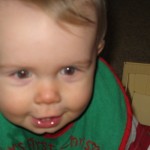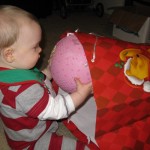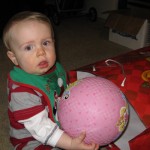INTUITIVE FOCUSING: FROM INTUITION TO CREATIVITY, TRANSFORMATION, PARADIGM SHIFTS.PHOTOS OF CHILD’S FIRST CHRISTMAS PRESENT ILLUSTRATE CLICK!
- Curiosity! What Will I Find Inside?
- Taking A Peek Inside
- Going Deeper
- “Ahah!”: Finding Something New
- Gifts From The Depths
Malcolm Gladwell, in Blink: The Power of Thinking Without Thinking (Little, Brown, 2005) shows that, contrary to popular belief, the majority of decisions are not made through careful listing of pros and cons but through following a “gut instinct” or an “intuition.” Intuitive Focusing , often accompanied by Focused Listening, is a predictable self-help skill for “unpacking” these “intuitive feels,” “bodily-felt senses” into usable insights and action steps, for personal growth, creativity, spirituality, intimacy, parenting, innovative decision making and problem solving at home and at work.
A child’s wonder at discovering a first Christmas present at the bottom of a deep bag provides a good symbol for the wonder and transformation to be found by using Focusing for “sitting with” and “going deeper into” the vague, preverbal information constantly offered up by the body/mind, the deeper psyche.
Working with Flavia Cymbalista, Focusing Teacher at www.marketfocusing.com , George Soros and other financial managers explored the use of Focusing in relation to “gut instincts” amidst the uncertainty of financial markets.
Over the last 30+ years, thousands of people have used Focusing for emotional, spiritual, and creative problem solving.
The six steps of the Focusing Process, from Eugene Gendlin’s self-help book, Focusing (Bantam, 1981, 1984):
Step One: Clearing A Space
Deciding to stop and take the time to sit down and pay attention to what is going on inside, the “preverbal” feel of your living, problems, decision making.
Step Two: Getting A Felt Sense
Setting aside all of your already-known intellectual answers and waiting quietly, as long as a minute, for the “bodily felt sense” of “this whole question” to arise.
Step Three: Finding A Handle
Carefully looking for words/images/gestures that can begin to describe the “bodily-felt sense” : “jumpy,” “like a whirly-gig, going round and round,” ” wanting to scrunch down into a tiny ball, disappear,” etc.
Step Four: Resonating And Checking
Taking any symbols (words/images/gestures) that come, and carefully going back and forth between the symbols and the “intuitive feel,” until the body-sense says, “Yes! That is exactly right! That fits perfectly!”
Step Five: Asking
Going deeper by asking the “intuitive feel” open-ended questions like, “And what is so important about that?” or “And what is the crux of that whole thing?” or “And why does that make me feel sad?”, and, instead of answering from the “head,” waiting each time, again at least for a minute, for the “bodily-felt sense,” the vague, preverbal knowing, to arise in the middle of the body, around the chest/heart area, and only then carefully looking for a Handle word/image/gesture, and Resonating and Checking until the body says “Yes! That is it!”. Continuing this Asking as long as you like or until you experience a “felt shift”: “Yes, that is exactly it. Now I understand what is going on and what I need to do to act on this information.
Step Six: Receiving
Taking a moment to “live into” this new knowing, let it sink into the cellular level of the body. Taking a moment to be grateful to the “body/mind” for offering you this information. Taking a moment to receive any new insights that have come before going into action.
You can read a more thorough description of Dr. McGuire’s version, The PRISMS/S Problem Solving Process.
You can read applications Including Focusing Alone, Focusing Partnerships, Interpersonal Focusing for Conflict Resolution, Creative Edge Meetings, Creative Edge Organizations in The Creative Edge Pyramid.
See my article, “Creative Edge Organizations: Businesses and Organizations As A ‘Kind’ Of Focusing Community” from The Folio: Thirtieth Anniversity Tribute edition at The Focusing Institute, www.focusing.org .
You can learn all about Intuitive Focusing and Focused Listening with the many resources listed below:
CREATIVE EDGE FOCUSING(tm): SELF-HELP SKILLS FOR HOME AND WORK
Free Downloads:
Complete Focusing Instructions Manual (17 pages)
“Ajas” Instantaneos Mini-Manual
Creative Edge Focusing (www.cefocusing.com ) teaches two basic self-help skills, Intuitive Focusing and Focused Listening, which can be applied at home and at work through The Creative Edge Focusing Pyramid.
Based upon Gendlin’s Experiential Focusing (www.focusing.org ) and Rogers’ Empathic Listening, our website is packed with Free Resources and instructions in these basic self-help skills. Learn how to build Support Groups, Conscious Relationships, and Creative Edge Organizations based upon these basic skills of emotional intelligence.
You can try out “Focusing: Find Out What Is Bothering You.”
Click here for a free Intuitive Focusing Mini-Course
Click here for a free Focused Listening Mini-Course
See Core Concept: Conflict Resolution to find a complete mini-course on Interpersonal Focusing and Conflict Resolution, including Rosenberg’s Non-Violent Communication, Blanchard’s “One Minute Apology,” Patricia Evan’s books on Verbally Abuse and Controlling Relationships, McMahon’s Beyond The Myth Of Dominance, and much more.
See Core Concept: Intimate Relationship to find a complete mini-course on increasing intimacy and sexuality, including the “Sharing Your Day” exercise, Listening/Focusing Partnerships for The Way of Relationship, untangling and equalizing desire, tantric sexuality, and much more.
Download complete Instant “Ahah!” Mini-Manual, in English and Spanish, from CEF Website, or download from links at top of this blog.
Find links to free articles, personality tests, multi-media Self-Help training, Classes and workshops
Dr. Kathy McGuire, Director




